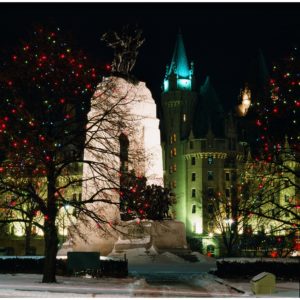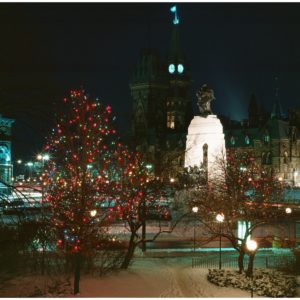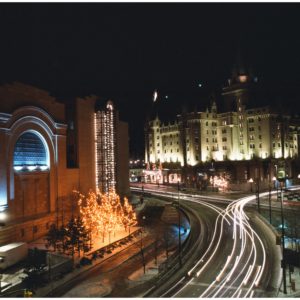OTTAWA PROFESSIONAL PHOTOGRAPHER BLOG POST RYAN STUDIO SERVING KANATA, NEPEAN, STITTSVILLE, BARRHAVEN, MANOTICK, ORLEANS
OTTAWA PROFESSIONAL ARCHITECURE PHOTOGRAPHY STUDIO JEFF RYAN PHOTOGRAPHY/ON LOCATION / PHOTOGRAPHERS BLOG / SERVING KANATA / STITTSVILLE / BARRHAVEN / MANOTICK / ORLEANS
MARCH, 2021
“ALONE THIS EVENING AS I WALKED THE DOWNTOWN CORE. AN OTTAWA PHOTOGRAPHERS RECOLLECTIONS”
This was, years ago, an exceptionally cold winter period pertaining to image creation or other outdoor events. I recall it well. On several occasions during winter months, I have frequently been attracted to the downtown core of Ottawa with it’s decorative holiday lighting creating levels of excitement, absent at other times of the year. When I make the decision to visit monuments and noteworthy places in general, planning for this type of photo engagement is necessary. Things to take into consideration are naturally, the weather on the day of the outing. To many, this may seem relatively unimportant with such a flourish of colour from Christmas tree lighting but it is something to consider.

My thoughts pertaining to late night winter photography sessions are as follows: Will the skies represent cloudy conditions which will record as soft white decreasing the contrast of the scene or will it be a clear unobstructed sky rendering itself to black which is certainly in my opinion, preferable. Will there be high winds forecasted for the evenings session causing ornamental lighting to blur due to relatively long time exposures required to record the scene due to lack of brightness preventing high shutter speeds? Which medium will I use to record these images….my professional film or digital camera. If my film camera, which film would be preferred over others to record successful renditions of the scenes? What time of night would best suit my needs to produce imagery with a limited amount of people in the viewfinder, distracting at times from my main subject? What tripod system would best suffice for stability due to long exposures? What clothing will be required to ensure warmth over a photo session lasting several hours in minus degree temperatures?
All these concerns I have listed are important to address for several reasons but primarily, to recognize a productive, enjoyable photographic venture. To elaborate regarding the previous comments……I intentionally waited the weather patterns out so to speak until the right conditions presented themselves. This delay pertaining to uncooperative weather means that I had to make myself available for several nights anticipating a more feasible situation than that which had been presented to me. When the time was right, I made my way to this area and began my photography at approximately 10:00pm. Prior to arriving on the day itself, I visited the area on a couple of occasions determining the best angles and view points to take into consideration prior to executing the session. This was a long evening of image making lasting a duration of four hours. I visited a few nearby locations this evening and the solitude and overall stillness was exhilarating. During these times of tranquility, one is given the opportunity to reflect upon many thoughts, as most individuals are accompanied by others at this time in the comfort of their homes or otherwise. The common hustle of the downtown core had long departed but knowing the regular level of activity would soon return proved enlightening in it’s own way.

The camera system I elected to use was my completely manual Hasselblad 500CM 120 film format product. This was absolutely the best choice due to the extremity of cold weather. Camera systems of this nature excel over highly electronic products requiring batteries for metering purposes or to trip the shutter. Products-(electronic digital or automatic battery film cameras for example) frequently fail under adverse conditions. I encountered no such difficulties during this evening at -30 with the wind chill factored in. Manual cameras do not have the same concerns as camera systems so dependent upon electrical current to power them. The decision was made to use both daylight and in particular tungsten transparency film this evening with it’s ability to record more accurate colours of the overall environment. The pleasure of using a camera such as the Hasselblad is that it’s film backs are removable and changing from one type of film to the other in a matter of seconds is impressive. I always ensure that I have my film backs “pre-loaded” prior to arriving at the scene ensuring effortless recording of imagery. Loading film at such frigid temperatures can be extremely hard on your hands making fingers freeze quickly, and film very awkward to handle. A series of lenses accompanied me this evening ranging from wide angle to medium telephoto and with the inclusion of my black cardboard shutter used to time each of the exposures, I was well prepared for this evenings event. Today’s digital cameras have diversified “white balance” settings permitting them the ability to create imagery under several varied lighting conditions, and afterwards manipulating these effects even further into computer programs. For obvious reasons, they would not have to be concerned as to which is the correct film emulsion to utilize. However, there is a true delight upon viewing professional transparencies on a light table once returned from the lab. Out of town labs are servicing professional photographers who record imagery on transparency film format should one consider any level of experimentation and comparison to a digital file.

When the 2:00am chimes resonated on the Peace Tower I knew it was time to conclude my outing due to the severity of cold and obvious levels of fatigue. As a suggestion to the reader who might attempt a photo session of this nature is to not transfer your camera equipment from the extreme cold, directly into the warm temperatures of your house. Remarkable levels of condensation occur on the outside and in particular, the inside of all working components often damaging the lubrication of equipment. A recommendation would be to bring with you larger zip lock freezer bags and insert your equipment in them, piece by piece sealing them, and then enter your home environment. The troubling and often excessive condensation will more often than not, accumulate on the inside of the plastic freezer bags and not your valuable gear.
Nighttime photography can be very exciting when one takes into consideration the differences between it and daytime image creation. An alternate suggestion would be to venture out on a rainy summer night recording the stunning colours of wet streets reflecting neon signs and other related material. As a photographer who has recorded excessive amounts of imagery in my career, I can assure the reader that this in itself is an excellent education in the process of learning to see and develop an artistic interpretation of your environment.
With My Good Wishes Extended,
Jeff Ryan Photography/Ryan Photography Studio Ottawa
E-mail- jeffryan@storm.ca
613-599-5363
www.jeffryan-photography.com
